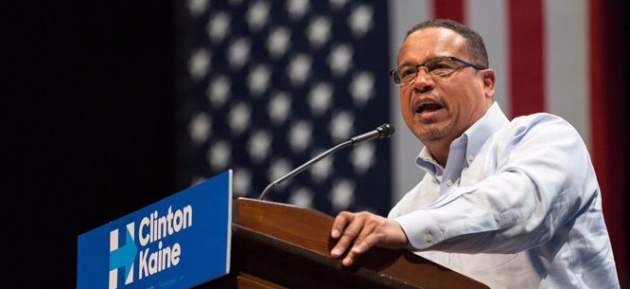In the spring, Donald Trump broke the Republican Party establishment; last week, the Democrats had their turn. Having secured control of the White House, Congress, and, soon, the Supreme Court, the GOP is positioned to enact a sweeping agenda. But there is a bright spot in this gloomy political landscape. The battle to determine the future of the Democratic Party has already begun, and for the first time since the New Deal this is a battle the left can win.
Where Democrats move next will be dictated by their assessment of how they got here. Clinton’s run was premised on the assumption that she would inherit the Obama coalition—millennials of all races, racial minorities of all ages, and enough older whites to retain an overall majority. In a country growing more diverse each year, this was the electorate of the future. Democrats would solidify their hold on the White House by deploying the most sophisticated statistical analysis to turn out their base, converting electioneering from an art into a science. Demographics and data were destiny—until voters put forward a model of their own. Democrats had mistaken campaigns based on Obama’s distinctive appeal for a new stage in political history. Now they have learned what happens when they run on Obama’s platform without Obama.
Attention has so far concentrated on Clinton’s loss among the white working class, a decline captured by Trump’s landslide victory among white men without college degrees. The scale of the downturn took Clinton’s team by surprise, but they had known Trump would outperform them in that demographic. What shocked the campaign’s statistical wizards—and what has attracted less notice in election postmortems—was Clinton’s performance with college-educated whites. Before the election, conventional wisdom held that Clinton would become the first Democrat to break Republicans’ longtime hold over that cohort. Instead, they came home to Trump. When combined with depressed turnout in the groups Clinton needed to carry, it was enough to eke out wins in key swing states. Clinton dominated Trump in affluent suburbs but came up short in the middle ground between Scarsdale and Brexit America. The defeat was not only about voters Trump stole from Clinton; it was about voters she couldn’t steal from him.
Neither fact suggests that, in seeking to reclaim these voters, Democrats must accommodate the white nationalism Trump’s campaign has pushed into the foreground of American politics. According to exit polls, some 60 percent of the country disapproved of Trump on election day. He won because a majority also disapproved of Clinton, and voters were hungry enough for change to swallow their objections to him. A Democrat who did not personify the status quo and was not weighed down by decades of partisan warfare could have encountered a very different reception.
Nor do the numbers indicate the party should lurch to the center. Anxious moderates, especially veterans of the Clinton wars in nineties, are already warning that the party will doom its chances by shifting to the left. That caution betrays a fundamental misunderstanding of the contemporary political scene. Parties recover from defeat in two ways. They can try to beat the opposition at their own game, accommodating the other side in an attempt to woo swing voters, as Bill Clinton did in 1992. But they can also try to change the rules of the game, offering a fundamental contrast with their opponents that reframes the debate and makes new coalitions possible. Ronald Reagan did it in 1980, Barack Obama did it in 2008, and, unfortunately, Donald Trump did it in 2016.
Trump represents change now, but he will soon become the status quo, and eventually voters will seek a corrective—just as in 2000 they traded an oversexed Rhodes Scholar for a Bible-fearing Texan proud of his anti-intellectualism, who then gave way to a cerebral black man with the middle name “Hussein,” who was then succeeded by the nation’s birther-in-chief. Eventually, Trump’s corrective will emerge. It is Democrats’ responsibility to find that candidate by 2020.
Nostalgia for the nineties among centrist Democrats becomes even more curious when one recalls the conditions under which their own faction emerged. Back in 1992, New Democrats never tired of complaining about intraparty rivals who thought Franklin Roosevelt’s politics had a place in Reagan’s America. The party needed to adapt, they argued, in order to survive. Signs of liberalism’s evolution included welfare reform; a crime bill targeting “superpredators”; the Defense of Marriage Act; and a political economy based on appeasing bond markets, rushing headlong into globalization, deregulating the financial sector, and pretending that an economic boom wasn’t made possible by the tech bubble.
However defensible this agenda was twenty years ago, it no longer fits the needs of the time. Clinton Democrats have become prisoners of their history, presenting as eternal political truths clichés that already sounded tired in the editorial pages of the Lewinsky-era Washington Post . Those who claim that burying Clintonism amounts to a repudiation of liberalism should reexamine the former president’s own words. In the speech launching his run for the White House, Clinton skittered away from the liberal label. “The change we must make isn’t liberal or conservative,” he said. “It’s different and it’s both.” Compare that with Bernie Sanders, the democratic socialist who depicted himself as a proud heir to FDR and LBJ. Then ask which program New Deal liberals would have recognized as their successor.
The failure of the Democratic establishment has also made third parties on the left more attractive than at any time in generations. The calculus will vary at the state and local levels, but Trump’s victory demonstrates why that option should be resisted nationally, at least for now. The waning influence of party elites has made it easier for ideologically motivated candidates to win primaries, and escalating partisan polarization has made these nominations more valuable prizes. Trump’s supporters won him the nomination; Clinton’s opponents delivered him the presidency. Although the interplay between these dynamics proved disastrous in 2016, it could in future provide the left with a powerful weapon.
Earlier this year it almost did. Bernie Sanders’s campaign, bitterly denounced by Clinton supporters at the time, is one of the best reasons for Democratic optimism today. Not since Reagan conservatives took over the GOP has a movement within one of the two major parties been better positioned. In 1976 as today, activists could point to the enthusiasm generated by their candidate against an establishment favorite who went on to lose the general election, undercutting the old guard’s legitimacy and clearing the way for a new approach. The coming years will be a chaotic time in Democratic politics. Progressives from the left wing of the party will vie with holdouts from the Clinton era, while both define their relationship to the burgeoning anti-Trump resistance. The Tea Party movement had begun to coalesce by the end of Obama’s first month in office, with their first official protests following soon after. Within seventy-two hours of Trump’s election, protests had broken out in thirty-seven cities. The passion behind this campaign is real. The first politicians to channel it effectively will become leaders in the next Democratic Party.
Popular national figureheads like Bernie Sanders and Elizabeth Warren, a roster of organizers trained by the grueling 2016 primaries, a compelling electoral rationale, a well of ideas to draw upon, and energy from a rising generation of young voters—not since the Depression have so many factors come together in the left’s favor. Debates about the direction of the party that were stifled by the need to rally around Obama in the Great Recession are finally bursting into the open. These are arguments Democrats need to have—and they are arguments the left should win.
Victory is far from inevitable. The temptation to turn the party into a haven for cosmopolitan meritocrats who feel out of place in Trump’s America will be strong. Moderates will argue that winning back working-class voters enamored of Trump is a doomed enterprise, especially if the wealthy continue fleeing the Republican Party—and when their dollars can fund efforts to woo Trump’s reluctant suburban backers. But in politics today money isn’t what it used to be, a lesson that cost Hillary Clinton, Jeb Bush, Ted Cruz, and Marco Rubio almost a billion dollars to learn. What matters most is the passion generated by the right campaign at the right time. The donor class couldn’t buy that in 2016, and they won’t be able to in 2020.
Politics in the years ahead will be framed by the actions of the Trump administration. Given our incoming president’s mercurial temperament, it’s impossible to predict what those actions will be. But it seems likely that he will give Democrats one more advantage in the coming struggles. As the difficulties encountered by the Sanders campaign demonstrated, the challenge of devising a left-wing agenda that holds together class, identity, culture is still far from resolved. But imagine if there were a figure who draped a program dedicated to the interest of the 1 percent in appeals to white nationalism, who both embodied the patriarchy and crusaded against women’s interests, who denied the existence of climate change, who targeted the vulnerable and marginalized with surgical precision, and who flirted with authoritarianism before even taking office. Next imagine that this figure occupied the most powerful position in American politics, forcing a daily reminder of the stakes in this conflict. There’s no replacement for a politics that ties the constituencies of the left into a cohesive whole. But an enemy who provides a shared target isn’t a bad substitute. Now we have one.



